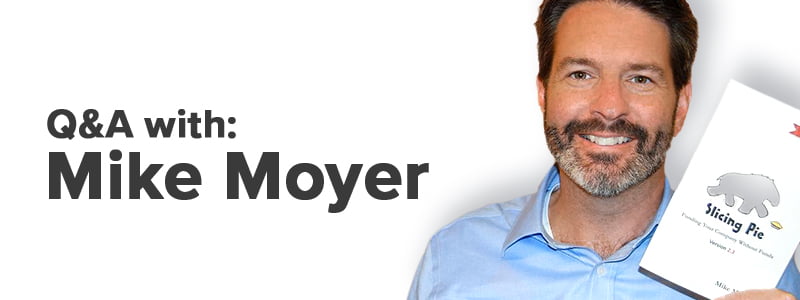One question every founder encounters is the dreaded equity allocation conundrum and how to best manage it.
Thankfully Slicing Pie is providing founders with a fair means of equity allocation all around the world. We caught up with its creator, Mike Moyer, to give us more insights here.
What inspired you to create Slicing Pie?
Over the years I’ve started or joined a number of startups and each time I struggled with understanding how to split the equity. I asked a lot of smart, successful, well-meaning people but I never got any meaningful insight. All the answers were different, the only consistent themes were recommendations based on financial projects, future contributions, rules-of-thumb and other highly subjective elements that were impossible to predict. With no other choice, I implemented the best I could and wound up getting screwed by cofounders and investors.
An equity model should be fair, logical, unambiguous, and based on facts, not on opinions. I began to see startups for what they really are: gambles. In established companies, people get paid. In startups, people don’t get paid. This characteristic sets startups apart from established companies in a very fundamental way. Unpaid amounts are at-risk and, therefore, bets. Thinking about it this way provides a common framework that makes perfect sense.
If you had to explain Slicing Pie to new founders in 1 minute what would you say?
Startup companies are a gamble, plain and simple. Every time a person contributes time, money, ideas, facilities, supplies, equipment or anything else and is not paid, the contribution is, in effect, a “bet” on the future profits or capital gains produced by the startup. The value of each person’s bet is always equal to the fair market value of the contribution. When the company reaches breakeven or a major round of funding the company can start paying people so the betting stops. A person’s share of the equity, therefore, should be based on that person’s share of the bets.
There is only one version of fairness. Equity distribution in a startup is either fair or it’s not. The only way to calculate a fair split is to consider the relative value of each person’s bet. This is the basis for the Slicing Pie model. It is the only model that reflects reality. All other equity-split models are based on predictions of future events or guesses.
What’s involved in implementing the model?
It’s very simple. All you have to do is keep track of each person’s bets. Bets are the unpaid portion of the fair market value of a contribution such as time, money, ideas etc. Everything can be bought and sold in an open market and has an observable price (except for things that are worthless or priceless!)
Keeping track is quite easy and can be done on a spreadsheet or with the Slicing Pie software found on www.slicingpie.com. Most companies track these things in the normal course of business. They track payroll, expenses, commissions, etc. In Slicing Pie you simply track these things too. The difference is that established companies track what they spend, a Slicing Pie company tracks what it does not spend.
Besides tracking, most companies will want to have a legal document in place. Slicing Pie is universal, but legal environments are not. It’s useful, therefore, to consult a Slicing Pie-friendly lawyer or accountant to make sure everything is in order and you can avoid unnecessary taxes. There is no reason a Slicing Pie company would incur taxes that non-Slicing Pie companies would not. All equity splits change over time as a company evolves, Slicing Pie simply provides a logical framework for making the changes.
You’ve been promoting fair equity allocations for many years now through the Slicing Pie series of books, game, keynotes and many hours more in person – what’s the main question you receive from founders on this topic?
The secret sauce that makes the model work so well are the multipliers. In Slicing Pie, founders add two slices to the Pie for every non-cash dollar (or other unit of currency) and four slices to the Pie for every dollar in cash. This adjustment properly accounts for risk, the scarcity of cash, global tax rates and aligns the interests of the team. They are not random numbers, but people often ask about them and wonder if they can be changed. Changing them decreases the model’s ability to be fair and, therefore, I discourage it!
What main changes have you seen for the model?
I originally thought Slicing Pie would be kind of a flexible “hacker” model that could be adapted depending on the situation. Over time, however, it became clear that changes only decreased its effectiveness. There is only one version of fairness so there can only be one model that uncovers fairness.
The original Slicing Pie book had some ideas for changes or “hacks” that I no longer recommend. Many of these things were removed from the later Slicing Pie Handbook, but the basic model remains the same.
Stick to the model, it always works!
Founder says, “we’ve already setup the company but want to apply the Slicing Pie methodology”– what’s your response here?
This is actually one of the most common ways people find Slicing Pie. They did a traditional fixed split and, when it began to backfire, they find Slicing Pie when they start researching how to fix the problem!
A “retrofit” is when you look back over the history of the company and apply the formula to see where the team should be. In most cases, team members will agree to adjust the split and move forward with Slicing Pie, but sometimes an existing founder’s agreement will unfairly reward a participant and he or she won’t want to budge. Unfair legal contracts allow people to behave like jerks! Rest assured, however, that as long as the other teammates agree to use Slicing Pie you can move forward. The Slicing Pie Recovery Framework outlines how to get rid of someone and treat them fairly.
Was this article helpful?
Related Posts
- Preference Shares
Preference Shares are a separate class of share and have features which can be used…
- Slicing the Pie – How ESS and ESOP arrangements work
The performance of your team can make or break your chances of success. Incentive better…
- Best Government Grants for Startups in 2019
Looking for the best government grants for startups? Some of these should be your first…
- Building the Team of A Players in Your Startup
A startup is only as good as the team behind it. How can you identify…
















